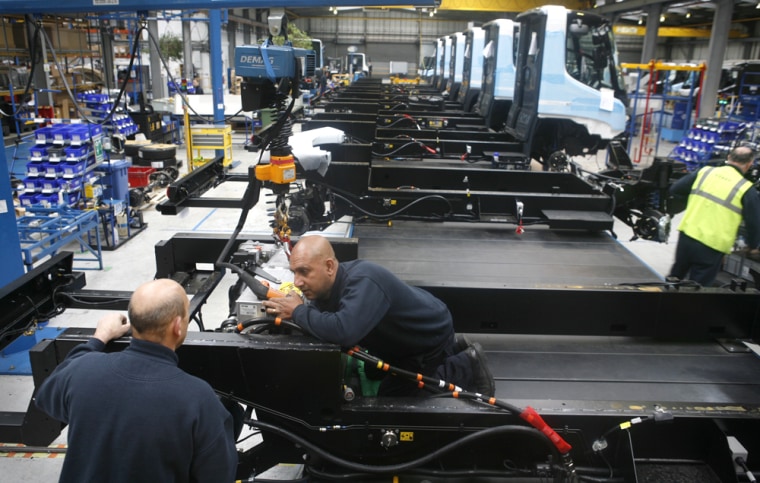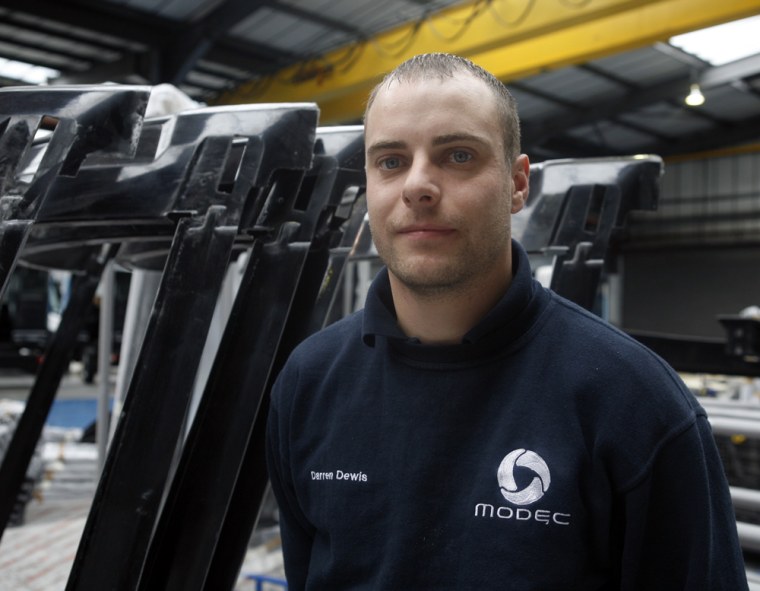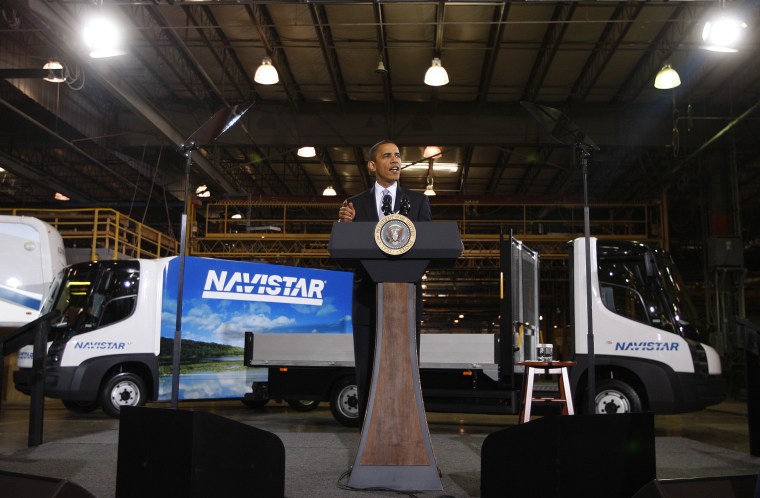Photographs of President Barack Obama run on a constant loop in the foyer of a factory here, roughly 100 miles northwest of London.
Shots from the photo-op show the president standing in front of trucks with “Navistar” emblazoned on the front and side, a publicity coup for the major American commercial truck and bus manufacturer.
But why are these photos being shown in Coventry, Britain’s down-at-heel equivalent of Detroit?
The answer lies in the flat-fronted truck looming behind the president: It wasn’t made in Illinois, site of Navistar’s headquarters, or Indiana, where the photos were taken; the vehicle was made at a factory in Coventry by Modec, a small British producer of battery-powered trucks.
“It was hard to believe that the most powerful man in the world was in front of a Modec,” said Darren Dewis, one of about 85 people employed at the company’s airy, glass-ceilinged factory. “It was brilliant, we were over the moon,” the 29-year-old cab assembly worker said of the first time he and his fellow workers saw the pictures.
Dewis has reason to be pleased with Obama: Under a nearly-finalized joint venture with Navistar — an arrangement backed by U.S. stimulus funds — Dewis and his Modec colleagues will get to produce more of the kind of truck seen with the American president.
The deal shows how some of America’s $787 billion stimulus package is trickling beyond its shores, and also how some U.S. companies are having to reach out abroad for the cutting-edge technologies that the president hopes will help spark a broad recovery and foster “green” manufacturing jobs.
‘Right here in America’
On Aug. 5, Obama unveiled plans that would allow Navistar to receive $39 million in federal money to build electric battery-powered commercial trucks with Modec. The funds were part of a larger pool of money being made available to American manufacturers.
“I’m here today … to announce $2.4 billion in highly competitive grants to develop the next generation of fuel-efficient cars and trucks powered by the next generation of battery technologies, all made right here in the U.S. of A. Right here in America. Made in America,” Obama said inside Navistar’s Wakarusa, Ind., facility to a round of applause from local officials and factory workers.

But while Navistar and Modec eventually plan to establish manufacturing facilities in the United States, the first batch of their battery-powered vehicles will come off the shop floor in England, not America.
Before the joint venture, Modec produced up to 15 trucks a week at its Coventry factory, and counted UPS, FedEx and Tesco, Britain’s largest retailer, among its customers. But the Navistar joint venture is the five-year-old firm’s biggest success by far.
Under the joint venture, the companies plan to build 400 battery-powered vehicles by 2010, and several thousand vehicles per year after that, Navistar said. The deal will eventually create up to 700 jobs in the U.S., the company said.
The first handful of trucks are scheduled to arrive in the United States on Dec. 25.
“A Christmas present for Navistar,” said Chris Wolfe, operations director for Modec.
An ‘ironic’ announcement?
The president unveiled his automotive grants just a few months after iconic automotive firms Chrysler and General Motors staggered toward bankruptcy and were bailed out with billions of U.S. taxpayer dollars. His promise that the grants would support products “made in America” came in Elkhart County, Ind., a community devastated by the shrinking recreational vehicle industry.
But the fact that much of the new technology would initially come from outside the country was not lost on Modec’s workers.
“If he wants to call it American and produce millions of them, let him get on with it,” quipped Stephen O’Neal, 43, who works as a team leader on Modec’s assembly line. “As long as he keeps selling them and Americans keep buying them, we’ll produce as many as you want.”
Discuss: Is this a good deal for U.S. taxpayers?
Some in the United States also noticed that the president was hyping a U.K.-made vehicle during his Wakarusa announcement.

"We did find it quite ironic that the president of the United States stood at the Navistar plant proclaiming his passion to build fuel-efficient cars and trucks in the United States … standing in front of a Modec vehicle,” said John Waters, the chief executive of Anderson, Ind.,-based Bright Automotive, which has developed a prototype hybrid-electric delivery van.
Bright is also vying for some of the billions of dollars that the administration has decided to spend to promote electric and battery technology.
Waters was part of the team that developed General Motors’ EV1 in the 1990s, an electric car that quickly gained a small, devoted following but was eventually scrapped by the company.
“(Obama) is giving money to U.S. companies importing vehicles and not exporting them,” Waters said. “There is a contradiction there in terms of image and messaging.”
Perhaps sensitive to the perception their collaboration is creating, Modec and Navistar are circumspect about where exactly the U.S. government money is going and whether some of the $39 million will go directly into Modec’s coffers.
Navistar’s spokesman Roy Wiley also declined to say when exactly the vehicles would start being produced in the United States.
“I won’t respond to timeline questions,” he said. “We’ll start production when we start production.”
‘Investing in the future’
Matt Rogers, the Department of Energy’s senior adviser in implementing the Recovery Act program, said the Modec-Navistar deal makes good sense for Americans.
Roughly a third of the Recovery Act was meant to halt the economy’s downward spiral, said Rogers, who was a senior partner at consulting firm McKinsey & Co. before joining the Department of Energy. Another third was aimed at helping states suddenly caught short of essential cash.
The remaining third was earmarked to foster investment in technology that will have a long-term impact, both in terms of jobs and new technologies, he said.
“(The Navistar-MODEC joint venture) is going into a former recreational vehicle factory and restarting production in that factory with advanced technology,” he said. “We need to attract new technologies and accelerate the adoption of new technologies in the automotive sector,” he added.
U.S. companies certainly are getting serious government incentives to spur innovation.
Under the American Recovery and Reinvestment Act of 2009, $112 billion will be invested in so-called "green" technologies, and $2 billion will be earmarked for renewable energy research. Obama has also proposed adding $15 billion a year to renewable energy research.
One of the reasons that so many billions need to be spent to get U.S. manufacturers up-to-speed is that for the last two decades or so the country’s leading automotive companies have lagged their foreign counterparts in developing innovative and fuel-efficient vehicles.
Buoyed by decades of a lax regulations and low fuel prices, giants like General Motors, Chrysler and Ford focused on building bigger vehicles full of creature comforts, with little regard for how much fuel they used.
“Where’s the innovation been in the last 20 years? In NAV systems, putting VCRs in cars – that’s not innovation, that’s getting my decorator in to redo my living room,” said Maryanne Keller, who wrote “Rude Awakening: The Rise, Fall and Struggle for Recovery of General Motors,” and “Collision: GM, Toyota, Volkswagen and The Race to Own the 21st Century.”
“Obama has basically said, ‘You will reach 30-plus miles per gallon,’ so everyone has gotten on the bandwagon, saying, ‘We’re not going to be able to BS our way out of this like we have for the last 25 years,” Keller said.
So after having fumbled with and even stifled cleaner and more fuel-efficient technology, according to industry insiders, America’s automotive industry is looking for partners to help it come up with that same technology – and fast.
Hence President Obama’s photo-op display in an English Midlands factory.
In the case of the Modec-Navistar deal, the American company looked for a partner that had a particular product ready to go instead of having to develop one from scratch, Keller said, adding that the deal makes “perfect sense.”
‘You can’t just take’
Back in the Coventry factory, the type of collaboration Keller describes is top of mind.
“We’ve all got individual skill sets and we will all struggle individually,” said Wolfe, the operations director. “But if we can get together … we can take this technology onto the next step.”
Dewis, the factory worker, who like many of his colleagues lost his job at Peugeot and struggled to find work before coming to Modec, sees the Navistar deal in a bigger context that has little to do with salary, profits and national borders.
For him, the electric-vehicle technology he works with could well change the world for the better.
“You’ve got to think about future generations and the way the planet is at the minute,” said Dewis, who has a 2-year-old daughter and a 6-year-old stepson. “You have got to give something back; you just can’t just take.”
